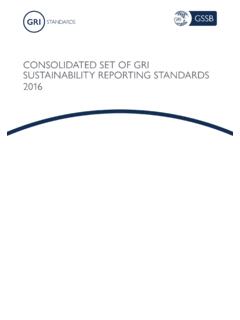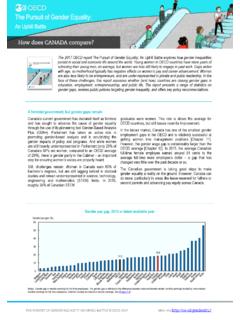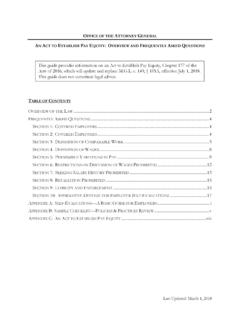Transcription of Manual for Trainers: Gender Equality and Gender ...
1 Manual for Trainers: Gender Equality and Gender mainstreaming module 1. module 1. module OVERVIEW. Gender , Gender CONCEPTS. TIME: 1h, 30min AND DEFINITIONS. OBJECTIVES: To understand Gender , Gender concepts and definitions. To reflect on Gender and Gender UNDERSTANDING KEY Gender TERMS. differences and their implications for societies. To become familiar with the AIM: Participants understand differences between Gender /sex, Gender national and international legal Equality /equity, and Gender Equality /women's rights. frameworks for Gender Equality . TIME: 40 min MATERIALS NEEDED: paper for participants, flip chart, markers, Power module OVERVIEW: Points - SESSION. 1. Understanding key 40 min STEP BY STEP GUIDE. Gender terms Step 1 Arrange participants in four groups. 2. Gender gap and 20 min Step 2 Ask group 1 to discuss and define terms Gender and patterns of Gender sex and explain the difference between them.
2 Ask group inequality 2 to do the same for terms transgender and transsexual , group 3 for terms Gender Equality and 3. Other Gender 20 min Gender equity and group 4 for terms Gender Equality concepts and and women's rights . terminologies Step 3 Ask participants to be as concrete as possible and use 4. Legal and political 10 min examples when possible. frameworks for Step 4 Inform them that they will have to report their findings in the plenary in 5 minutes time. Gender Equality Step 5 After 5 minutes, ask groups 1 to 4 to share their definitions. Note down their answers on a flip chart. Step 6 Present the participants with the definitions, using MATERIALS NEEDED: , discussing the differences between the - Flip charts, markers terms. Paper for participants VARIATION: Gender vs. SEX EXCERCISE 1. Power Points Step 7 When discussing the difference between Gender and sex, Small reward ( chocolate) for all participants additionally strengthen participants' understanding of the Youtube video on Gender GAP terms with short exercise using different statements on Report women and men (below).
3 Gender Gap Country Profile Step 8 Ask participants to write numbers 1 to 10 on a paper. (Annex ) Step 9 Read out the numbered list of statements about men and Simplified version of the women enclosed below and ask participants to write G. international Gender Equality against those they think refer to Gender , and S to those documents (Annexes , ) they think refer to sex. Quizz Cards (Annex ) Step 10 Discuss the answers in the group. You can ask participants, if: Any statement surprised them? Did the statements indicate that Gender is inborn or learned? Gender Equality vs. EQUITY. Step 11 After presenting the definition of Gender equity ask participants to identify Gender -equitable actions that men can take to help create Gender Equality in the community/household. 10. Manual for Trainers: Gender Equality and Gender mainstreaming module 1.
4 FACILITATOR'S NOTE. SEX vs. Gender . SEX Gender . Biological characteristics (including genetics, Socially constructed set of roles and anatomy and physiology) that generally define responsibilities associated with being girl and boy or humans as female or male. Note that these biological women and men, and in some cultures a third or characteristics are not mutually exclusive; however, other Gender . there are individuals who possess both male and female characteristics. Born with. Not born with. Natural. Learned. Universal, A-historical Gender roles vary greatly in different societies, No variation from culture to culture or time to time. cultures and historical periods as well as they depend also on socio-economic factors, age, education, ethnicity and religion. Cannot be changed, except with the medical Although deeply rooted, Gender roles can be treatment.
5 Changed over time, since social values and norms are not static. Example: Only women can give birth. Only women Example: The expectation of men to be economic can breastfeed. providers of the family and for women to be caregivers is a Gender norm in many cultural contexts. However, women prove able to do traditionally male jobs as well as men ( men and women can do housework; men and women can be leaders and managers). PRACTICAL POINT: At birth, the difference between boys and girls is their sex; as they grow up society gives them different roles, attributes, opportunities, privileges and rights that in the end create the social differences between men and women. EXCERCISE SEX vs. Gender : Statements about men and women 1. Women give birth to babies, men don't. (S). 2. Girls are gentle, boys are rough. (G).
6 3. In one case, when a child brought up as a girl learned that he was actually a boy, his school marks improved dramatically. (G). 4. Amongst Indian agriculture workers, women are paid 40-60 per cent of the male wage. (G). 5. In Europe, most long-distance truck drivers are men. (G). 6. Women can breastfeed babies, men can bottle-feed babies. (S). 7. Most building-site workers in Britain are men. (G). 8. In ancient Egypt men stayed at home and did weaving. Women handled family business. Women inherited property and men did not. (G). 9. Men's voices break at puberty; women's do not. (S). 10. In one study of 224 cultures, there were 5 in which men did all the cooking, and 36 in which women did all the housebuilding. (G). 11. According to UN statistics, women do 67 per cent of the world's work, yet their earnings for it amount to only 10.
7 Per cent of the world's income. (G). 12. There are more women than men in the caring professions such as nursing. (G). 13. Men are susceptible to prostate cancer, women are not. (S). Adopted from: International Federation of Red Cross and Red Crescent Societies, 2003. 11. Manual for Trainers: Gender Equality and Gender mainstreaming module 1. FACILITATOR'S NOTE. Gender Equality vs. Gender EQUITY. Gender Equality Gender EQUITY. The state or condition that affords women and men Justice and fairness in the treatment of women and men in equal enjoyment of human rights, socially valued order to eventually achieve Gender Equality , often goods, opportunities and resources, allowing both requesting differential treatment of women and men (or sexes the same opportunities and potential to specific measures) in order to compensate for the contribute to, and benefit from, all spheres of society historical and social disadvantages that prevent women and (economic, political, social, and cultural).
8 Men from sharing a level playing field. Example: A family has limited funds, and both Example: Provision of leadership training for women or daughter and son need new pair of shoes for the new establishing quotas for women in decision-making positions school year, but only one can get new shoes this year. in order to achieve the state of Gender Equality . If the family decides (and who in the family decides?). which child will get the new shoes based on the child's NEED, and not on the child's sex, this is an example of Gender Equality . IMPORTANT POINT! Equity leads to Equality ! Equity means that there is a need to continue taking differential actions to address historical inequality among men and women and achieve Gender Equality ! Gender Equality vs. WOMEN'S RIGHTS. Women s rights: entitlements that women have on the basis that they are human.
9 Normatively based in several international human rights documents ( The Convention on the Elimination of Discrimination Against Women (CEDAW)). Arranged around the concept of duty bearer& rights holder Gender Equality and non-discrimination on the basis of sex are fundamental human rights! Gender Equality implies equal enjoyment of rights by man and women. TRANSGENDER vs. TRANSSEXUAL. Transgender: refers to those trans people who live permanently in their preferred Gender , without necessarily needing to undergo any medical intervention/s. Transsexual: refers to people who identifies entirely with the Gender role opposite to the sex assigned to at birth and seeks to live permanently in the preferred Gender role. Transsexual people might intend to undergo, are undergoing or have undergone Gender reassignment treatment (which may or may not involve hormone therapy or surgery).
10 (Source: ILGA-Europe). 12. Manual for Trainers: Gender Equality and Gender mainstreaming module 1. Gender GAP and PATTERNS OF Gender INEQUALITY. AIM: To discuss indices of Gender inequality in participant's society. To understand the term Gender GAP. TIME: 20 min MATERIALS NEEDED: Paper for participants, flip chart, markers, Youtube video on Gender GAP Report 2014, Gender Gap Country Profile (example Annex ), Power Points STEP BY STEP GUIDE. Step 1 Ask the participants to share whether Gender inequality exists in their community/country. Step 2 Write down any statements that explain why women do not share equal status with men in all spheres of society. Step 3 Ask them what consequences this inequalities have for the development of their nations/on the global level. INTRODUCING Gender GAP. Step 4 Ask participants what term is used to explain the difference between men and women in any sphere.







